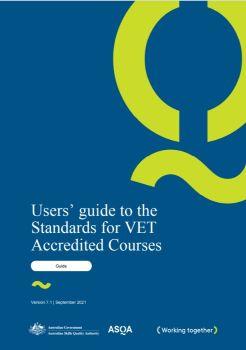- Home
- Course accreditation
- Apply for course accreditation
- Step 1—VET course concept
Step 1—VET course concept
Getting your course concept approved is the first step towards course accreditation.
What is a course concept?
A course concept provides high level information about your proposed course.
We check your course concept meets eligibility requirements for course accreditation.
Your course concept must be approved as eligible by ASQA before you begin detailed work on your course accreditation application.

Users’ guide to the Standards
We’ve created a guide to help you understand the Standards for VET Accredited Courses.
At this early stage the following standards are important:
What to include in your course concept
The information you need to provide is in the VET course concept form. You need to include:
- evidence there is a real industry need for your course
- details about your target group
- projected enrolment numbers
- details of all the stakeholders you intend to engage with
- proof of research (showing why your proposed course should be nationally recognised)
Stakeholder engagement is critical. It will help you build support for developing your course.
If your proposed course duplicates any existing training packages, it will not be approved.
How to research training package units
You need to identify units from training packages that may be suitable to include in your course.
Find out about researching training packages in Standard 9 of our Users’ Guide.
The content of all training packages is available on the national register.
Enterprise units
An enterprise unit is a unit of competency developed by a course owner to meet a skills and knowledge gap (not covered by existing units).
If you cannot find an existing training package unit to address a skills and knowledge gap, you can write your own enterprise unit.
Read about developing enterprise units in Standard 10.2.
Fees
| Lodgement fee: | If your course concept is not eligible to proceed, you will have to pay another lodgement fee to submit another VET course concept. |
Learn more about fees and charges
How to submit your course concept
Complete the VET course concept form and email it to courses@asqa.gov.au with supporting information.
Pay the lodgement fee.
Submit a course concept form for each course you want to accredit.
Assessment process
- Submit your course concept form with any attachments.
- We will check your submission to make sure it is complete.
- We will assess if your course concept meets the eligibility requirements for accreditation.
- If we need more information, you have the opportunity to provide additional information.
- We will write to you, confirming whether your course meets the eligibility requirements for accreditation and can proceed to course development (Step 2).
We process applications in line with ASQA’s service standards.
Decision
We will let you know if your course concept is approved. If so, you can proceed to course development (Step 2).
Once your course concept is approved, you have 6 months to develop your course and submit it for accreditation.
Your course concept may not be approved if:
- it does not meet the eligibility requirements
- you did not provide additional information within the required timeframe.
Contact us
If you have any questions about your course concept, please call 1300 701 801.
Related links
Share
